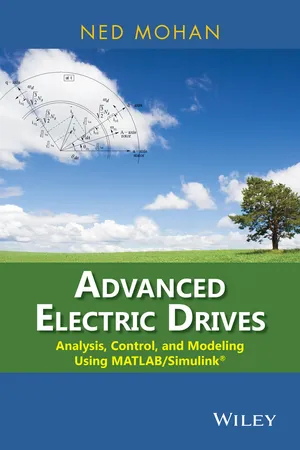
Advanced Electric Drives
Analysis, Control, and Modeling Using MATLAB / Simulink
- English
- ePUB (mobile friendly)
- Available on iOS & Android
About this book
With nearly two-thirds of global electricity consumed by electric motors, it should come as no surprise that their proper control represents appreciable energy savings. The efficient use of electric drives also has far-reaching applications in such areas as factory automation (robotics), clean transportation (hybrid-electric vehicles), and renewable (wind and solar) energy resource management. Advanced Electric Drives utilizes a physics-based approach to explain the fundamental concepts of modern electric drive control and its operation under dynamic conditions. Author Ned Mohan, a decades-long leader in Electrical Energy Systems (EES) education and research, reveals how the investment of proper controls, advanced MATLAB and Simulink simulations, and careful forethought in the design of energy systems translates to significant savings in energy and dollars. Offering students a fresh alternative to standard mathematical treatments of dq-axis transformation of a-b-c phase quantities, Mohan's unique physics-based approach "visualizes" a set of representative dq windings along an orthogonal set of axes and then relates their currents and voltages to the a-b-c phase quantities. Advanced Electric Drives is an invaluable resource to facilitate an understanding of the analysis, control, and modelling of electric machines. •Gives readers a "physical" picture of electric machines and drives without resorting to mathematical transformations for easy visualization •Confirms the physics-based analysis of electric drives mathematically •Provides readers with an analysis of electric machines in a way that can be easily interfaced to common power electronic converters and controlled using any control scheme •Makes the MATLAB/Simulink files used in examples available to anyone in an accompanying website •Reinforces fundamentals with a variety of discussion questions, concept quizzes, and homework problems
Frequently asked questions
- Essential is ideal for learners and professionals who enjoy exploring a wide range of subjects. Access the Essential Library with 800,000+ trusted titles and best-sellers across business, personal growth, and the humanities. Includes unlimited reading time and Standard Read Aloud voice.
- Complete: Perfect for advanced learners and researchers needing full, unrestricted access. Unlock 1.4M+ books across hundreds of subjects, including academic and specialized titles. The Complete Plan also includes advanced features like Premium Read Aloud and Research Assistant.
Please note we cannot support devices running on iOS 13 and Android 7 or earlier. Learn more about using the app.
Information
1
Applications: Speed and Torque Control

1-1 History
1-2 Background
1-3 Types of ac Drives Discussed and the Simulation Software
1-4 Structure of this Textbook
Table of contents
- Cover
- Table of Contents
- Title page
- Copyright page
- Preface
- Notation
- 1: Applications: Speed and Torque Control
- 2: Induction Machine Equations in Phase Quantities: Assisted by Space Vectors
- 3: Dynamic Analysis of Induction Machines in Terms of dq Windings
- 4: Vector Control of Induction-Motor Drives: A Qualitative Examination
- 5: Mathematical Description of Vector Control in Induction Machines
- 6: Detuning Effects in Induction Motor Vector Control
- 7: Dynamic Analysis of Doubly Fed Induction Generators and Their Vector Control
- 8: Space Vector Pulse Width-Modulated (SV-PWM) Inverters
- 9: Direct Torque Control (DTC) and Encoderless Operation of Induction Motor Drives
- 10: Vector Control of Permanent-Magnet Synchronous Motor Drives
- 11: Switched-Reluctance Motor (SRM) Drives
- Index
- End User License Agreement